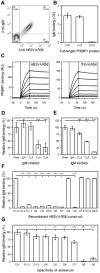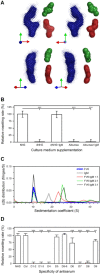Investigating the function of Fc-specific binding of IgM to Plasmodium falciparum erythrocyte membrane protein 1 mediating erythrocyte rosetting
- PMID: 25482886
- PMCID: PMC4737123
- DOI: 10.1111/cmi.12403
Investigating the function of Fc-specific binding of IgM to Plasmodium falciparum erythrocyte membrane protein 1 mediating erythrocyte rosetting
Abstract
Acquired protection from Plasmodium falciparum malaria takes years to develop, probably reflecting the ability of the parasites to evade immunity. A recent example of this is the binding of the Fc region of IgM to VAR2CSA-type PfEMP1. This interferes with specific IgG recognition and phagocytosis of opsonized infected erythrocytes (IEs) without compromising the placental IE adhesion mediated by this PfEMP1 type. IgM also binds via Fc to several other PfEMP1 proteins, where it has been proposed to facilitate rosetting (binding of uninfected erythrocytes to a central IE). To further dissect the functional role of Fc -mediated IgM binding to PfEMP1, we studied the PfEMP1 protein HB3VAR06, which mediates rosetting and binds IgM. Binding of IgM to this PfEMP1 involved the Fc domains Cμ3-Cμ4 in IgM and the penultimate DBL domain (DBLζ2) at the C-terminus of HB3VAR06. However, IgM binding did not inhibit specific IgG labelling of HB3VAR06 or shield IgG-opsonized IEs from phagocytosis. Instead, IgM was required for rosetting, and each pentameric IgM molecule could bind two HB3VAR06 molecules. Together, our data indicate that the primary function of Fc -mediated IgM binding in rosetting is not to shield IE from specific IgG recognition and phagocytosis as in VAR2CSA-type PfEMP1. Rather, the function appears to be strengthening of IE-erythrocyte interactions. In conclusion, our study provides new evidence on the molecular details and functional significance of rosetting, a long-recognized marker of parasites that cause severe P. falciparum malaria.
© 2014 The Authors. Cellular Microbiology published by John Wiley & Sons Ltd.
Figures





Similar articles
-
Evasion of immunity to Plasmodium falciparum malaria by IgM masking of protective IgG epitopes in infected erythrocyte surface-exposed PfEMP1.Proc Natl Acad Sci U S A. 2011 Jul 26;108(30):12485-90. doi: 10.1073/pnas.1103708108. Epub 2011 Jul 11. Proc Natl Acad Sci U S A. 2011. PMID: 21746929 Free PMC article.
-
Multiple Plasmodium falciparum Erythrocyte Membrane Protein 1 Variants per Genome Can Bind IgM via Its Fc Fragment Fcμ.Infect Immun. 2015 Oct;83(10):3972-81. doi: 10.1128/IAI.00337-15. Epub 2015 Jul 27. Infect Immun. 2015. PMID: 26216422 Free PMC article.
-
Comprehensive analysis of Fc-mediated IgM binding to the Plasmodium falciparum erythrocyte membrane protein 1 family in three parasite clones.Sci Rep. 2019 Apr 15;9(1):6050. doi: 10.1038/s41598-019-42585-0. Sci Rep. 2019. PMID: 30988351 Free PMC article.
-
Three Is a Crowd - New Insights into Rosetting in Plasmodium falciparum.Trends Parasitol. 2017 Apr;33(4):309-320. doi: 10.1016/j.pt.2016.12.012. Epub 2017 Jan 18. Trends Parasitol. 2017. PMID: 28109696 Review.
-
IgM, Fc mu Rs, and malarial immune evasion.J Immunol. 2010 May 1;184(9):4597-603. doi: 10.4049/jimmunol.1000203. J Immunol. 2010. PMID: 20410497 Free PMC article. Review.
Cited by
-
Influence of α2-Macroglobulin, Anti-Parasite IgM and ABO Blood Group on Rosetting in Plasmodium falciparum Clinical Isolates and Their Associations with Disease Severity in a Ghanaian Population.J Blood Med. 2022 Mar 18;13:151-164. doi: 10.2147/JBM.S329177. eCollection 2022. J Blood Med. 2022. PMID: 35330697 Free PMC article.
-
Cerebral Plasmodium falciparum malaria: The role of PfEMP1 in its pathogenesis and immunity, and PfEMP1-based vaccines to prevent it.Immunol Rev. 2020 Jan;293(1):230-252. doi: 10.1111/imr.12807. Epub 2019 Sep 27. Immunol Rev. 2020. PMID: 31562653 Free PMC article. Review.
-
PfEMP1 A-Type ICAM-1-Binding Domains Are Not Associated with Cerebral Malaria in Beninese Children.mBio. 2020 Nov 17;11(6):e02103-20. doi: 10.1128/mBio.02103-20. mBio. 2020. PMID: 33203751 Free PMC article.
-
PfEMP1 and var genes - Still of key importance in Plasmodium falciparum malaria pathogenesis and immunity.Adv Parasitol. 2024;125:53-103. doi: 10.1016/bs.apar.2024.02.001. Epub 2024 Mar 23. Adv Parasitol. 2024. PMID: 39095112 Free PMC article. Review.
-
Malaria and immunity during pregnancy and postpartum: a tale of two species.Parasitology. 2015 Jul;142(8):999-1015. doi: 10.1017/S0031182015000074. Epub 2015 Mar 3. Parasitology. 2015. PMID: 25731914 Free PMC article. Review.
References
-
- Barragan, A. , Spillmann, D. , Kremsner, P.G. , Wahlgren, M. , and Carlson, J. (1999) Plasmodium falciparum: molecular background to strain‐specific rosette disruption by glycosaminoglycans and sulfated glycoconjugates. Exp Parasitol 91: 133–143. - PubMed
-
- Barragan, A. , Fernandez, V. , Chen, Q. , von Euler, A. , Wahlgren, M. , and Spillmann, D. (2000a) The duffy‐binding‐like domain 1 of Plasmodium falciparum erythrocyte membrane protein 1 (PfEMP1) is a heparan sulfate ligand that requires 12 mers for binding. Blood 95: 3594–3599. - PubMed
Publication types
MeSH terms
Substances
Grants and funding
LinkOut - more resources
Full Text Sources
Other Literature Sources
Research Materials

